
Entrance to Palace Museum, Al Ain, Ancestral Home of the Ruling Family of Abu Dhabi
Camels and Skyscrapers
As the plane descended, I looked down onto the aquamarine waters of the Arabian Sea and desert along the shore. Then, as we circled toward the airport, buildings, roads, and neatly planted date orchards came into view. At one point we appeared to fly over a camel market. Soon the roads and buildings became more and more dense and we passed over housing developments and shopping malls. In the distance, I could see skyscrapers. We were getting ready to land in the United Arab Emirates, a country that in just fifty years has transformed itself from a tiny desert outpost to a land of gleaming modern metropolises.
I had never been to the Middle East before, and the plane trip, from LAX to Dubai, was the longest I had ever experienced (16 hours). When we landed, we were half-way around the world. The twelve hour time difference meant that I didn’t even have to change my watch! We were met by a representative from the conference my husband was attending, escorted through the super-sized terminal and then driven to Abu Dhabi, the other major city in the U.A.E. (In the UAE, it is preferable to be driven than to drive yourself.)
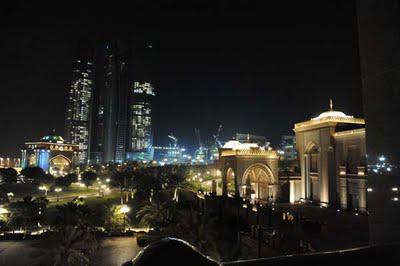
View from our room of the entrance to the Emirates Palace Hotel, with the Etihad Towers, a new hotel and business complex under construction in the background
The Most Expensive Hotel in the World
In Abu Dhabi, the conference was held at the luxurious Emirates Palace Hotel, by far, the most lavish hotel I have ever seen. It made me feel as if I had landed in a chapter of the Arabian Nights by mistake. (Luckily for us, our rooms were paid for as part of the conference.) Featuring gold covered ceilings, multiple five star restaurants, high-end shops, a private beach, two giant swimming pools, and more, it was so big, that one day after lunch I got lost on the way back to our room. For photos and more details about the over the top luxury at the Emirates Palace, read this article in the Sydney Morning Herald.
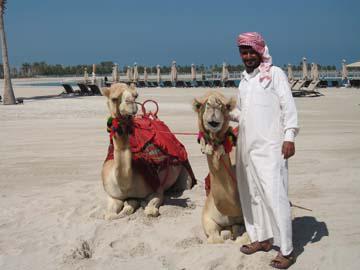
Camels on the beach in front of the Emirates Palace Hotel
But I didn’t really want to feel as if I’d flown half way around the world to spend a week in a fancy, land-bound cruise ship. I wanted to see what the U.A.E. was like outside the hotel. In preparation for the trip, I had read Diamond in the Desert: Behind the Scenes in Abu Dhabi, the World’s Richest City by Jo Tatchell, who had lived in Abu Dhabi as a child, when it was still largely undeveloped. It helped me to get a sense of where the UAE had come from and where it is today. I highly recommend it.
Heritage Village
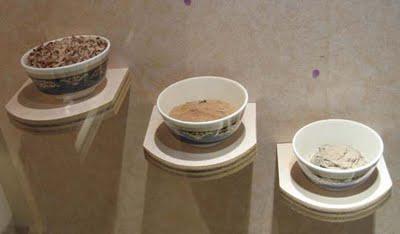
"Hinna" was and still is the most elegant traditional cosmetic used by women in the UAE. The UAE motifs can be distinguished from decorations of other regions in the gulf. The process includes drying the leaves, crushing and making the paste. Special containers were used to keep the mixture. (Exhibit in museum at Heritage Village)
Most of Abu Dhabi’s past has been bulldozed over. However, one place you can get a sense of local history is at the Heritage Village where there are reconstructions of typical Bedouin tents and houses, live camels, and a small museum displaying traditional clothing, jewelry, household items, etc.A Country of Superlatives
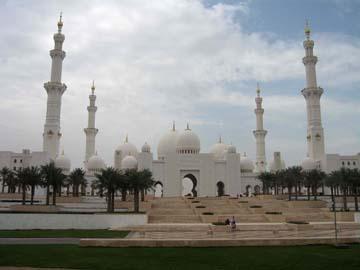
Sheikh Zayed Grand Mosque, Abu Dhabi. Can accommodate 22,000 worshipers. It is the largest mosque in the world.
Financed by the oil industry, development in the U.A.E. has proceeded at a frenetic pace (the country feels like one huge building site.) Everything is over the top. The country boasts the tallest building, the largest mosque, the biggest shopping mall, the largest dancing fountains, the most expensive hotels. A whole museum complex is being built that will include a satellite Louvre and Guggenheim plus two other museums. (Models are displayed at the Emirates Palace.)Al Ain, the Garden City
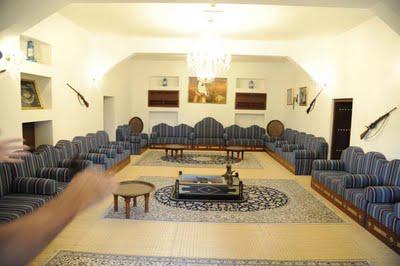
Majlis, or meeting room, at the Palace Museum in Al Ain, where most decisions were made when the palace was the center of government. Here was where the Sheikh received local and foreign dignitaries.
The UAE is a federation of seven emirates, (each originally a tribal or family based unit) that banded together after oil was discovered in 1958. Although they function as a political unit, they also retain some independence. On a MAP you can see that there are three major cities, Abu Dhabi and Dubai, both on the coast and Al Ain, which is inland and the ancestral home of the ruling family. After five nights in Abu Dhabi, we spent two days with friends in Al Ain.Al Ain is a desert oasis and promotes itself as a garden city. Before the discovery of oil, fresh water was in short supply. Now, oil powered electricity plants provide the energy for desalination, and water is pumped everywhere. For a desert country, the landscape is surprisingly green.
The Palace Museum
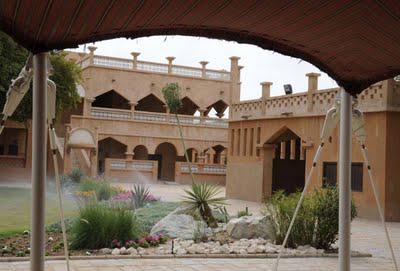
Interior courtyard of Palace Museum, Al Ain.
My favorite part of the trip was visiting the Palace Museum and Jalil Fort in Al Ain. Here one gets a glimpse of traditional life (bedrooms on the second floor taking advantage of cool breezes for natural air conditioning, meeting areas for men, separate areas for women and children.)Jalil Fort, Al Ain
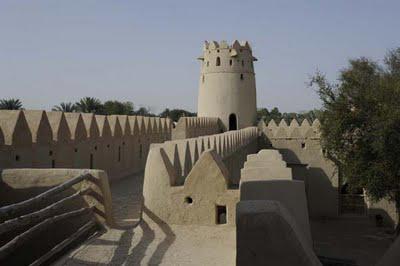
Ramparts of Al Jalil Fort, Al Ain
A Trip to the Zoo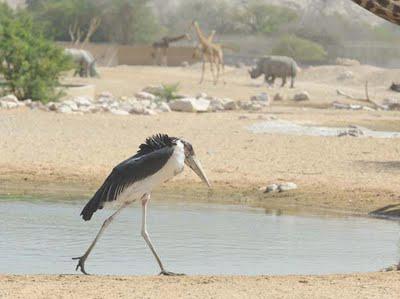
Marabou stork (native to Africa) at the Wildlife Park, Al Ain
Whenever I travel, I always like to go to the zoo. The zoo in Al Ain, recently remodeled, features the usual suspects (lions, tigers, giraffes, etc.) but also displays animals unique to the Arabian peninsula. On the day we visited (in February), the weather was sunny and cool. The animals were active and seemed to enjoy being out-of-doors.Shopping
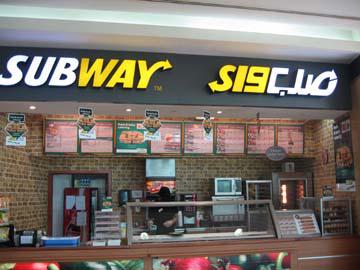
In food court of shopping mall, Al Ain. Note that "Subway" is spelled backward in Arabic.
Shopping malls and supermarkets provide most of the same kinds of things you can buy in Europe or the United States. We visited Carrefours, part of the French supermarket chain, and the associated mall, complete with an American style food court.The Weather
Our trip, in February, was made during a time when the weather in the UAE is optimal–warm during the day and cool at night. (I actually wished I had brought a warmer sweater for the evenings.) In summer, temperatures in the UAE apparently climb to 118 or more! Before there was air conditioning, people went to Al Ain from Abu Dhabi and Dubai in summer to get away from the damp sea air. It was better to be hot and dry than hot and humid.
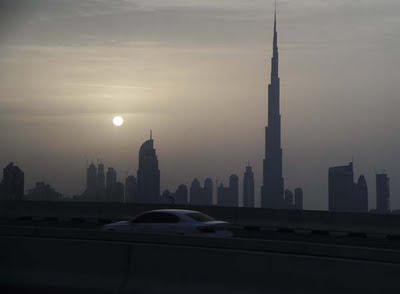
Dubai skyline with Burj Khalifa (at 2,716.5 feet), the tallest building in the world. The Burj was designed by the architectural firm of Skidmore, Owings and Merrill in Chicago.
Heading Home
Our last night was at the Premier Inn hotel near the airport in Dubai, chosen because of an early flight the next morning. The week felt like a whirlwind and there are still plenty of things I’d like to do if I go back again. I’d like to take a tour of the mosque (appropriate clothing is provided for women), go to one of the camel markets and/or camel races, do more birdwatching (actually, I saw quite a few birds on the hotel grounds), find out about local crafts, visit the falcon hospital, take a trip out into the desert. Nevertheless, for a first visit I felt I saw a lot and got a glimpse of life in the UAE. It is developing fast and, no doubt, will have even more to see in the future.
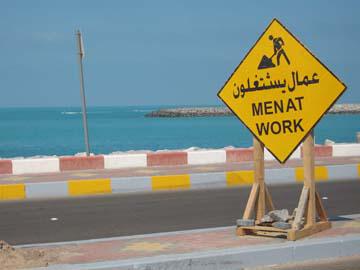
Road construction, Abu Dhabi. Note aquamarine water of the Arabian Gulf.
